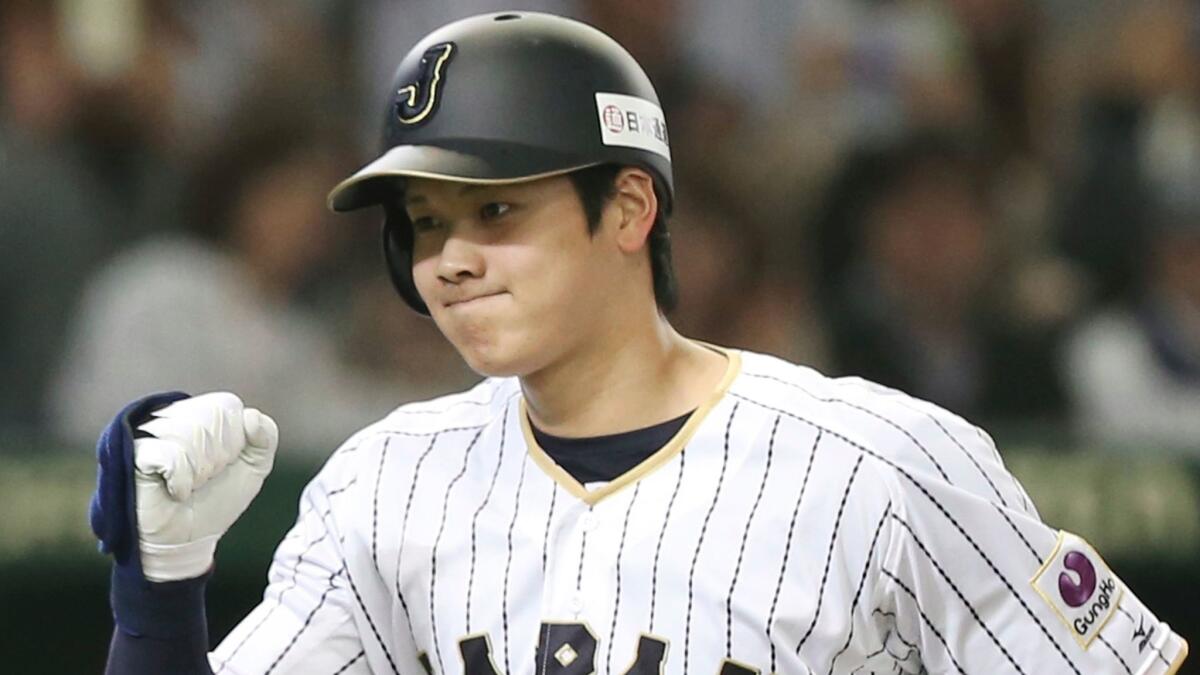Column: One key factor in Ohtani’s decision will be which team can be patient with his desire to pitch and hit

- Share via
Back in September, as Hiroshi Sasaki told stories about Shohei Ohtani in a visitor’s room at Hanamaki Higashi High School, the longtime baseball coach paused to ask a question of his own.
Would Ohtani be criticized for trying to play both ways in the major leagues?
Sasaki, who coached Ohtani in high school, remains a trusted confidant and advisor to the two-way star. I explained to Sasaki about baseball’s place in our sporting landscape, about the shortage of personalities and marketable stars. I told him Ohtani’s efforts would be embraced.
Well, at least initially.
I understood Sasaki’s concern. From a distance, particularly from overseas, what Ohtani does looks effortless, throwing 100 mph fastballs one day and literally launching baseballs through the roof of an indoor stadium on another. Except this didn’t happen overnight. Ohtani spent multiple seasons molding himself into an effective two-way player.
What if similar time is required for Ohtani to adjust to the major leagues?
That concern has to be on Ohtani’s mind as he decides on a major league team. Ohtani narrowed down the field of his possible destinations Monday, with the Dodgers and Angels making the short list of teams that will meet with Ohtani this week. The San Diego Padres, Seattle Mariners, San Francisco Giants, Texas Rangers and Chicago Cubs also remain in the mix.
The Yankees and the Red Sox are out. This shouldn’t have been a surprise. If Ohtani has made anything clear during this process, it’s that he wants to continue to pitch and hit.
As much standing around as there is in baseball, playing both ways is physically demanding, even with a designated-hitter rule in effect. The simple task of figuring out a schedule could take months, if not years. Ohtani’s team in Japan, the Nippon-Ham Fighters, took a couple of seasons to settle on how they would use him.
Performance is another matter. In his third season with the Fighters, Ohtani was 15-5 with a 2.24 earned-run average, but batted only .202 with five home runs. But the Fighters allowed Ohtani to continue to play both ways, living up to the promise they made him when they signed him out of high school.
Ohanti had an offensive breakthrough the next season, batting .322 with 22 home runs in 104 games.
Ohtani is now 23, five years older than he was when he started playing for the Fighters. But just because his learning curve might not be as steep as it was doesn’t mean there won’t be one. He hasn’t endured the grind of a major league schedule, which doesn’t have built-in days off every week, as is the case in Nippon Professional Baseball. He has rarely seen the kind of velocity he will see as a major league hitter.
Sasaki said he didn’t envision Ohtani signing with a team like the Yankees or Dodgers, citing Ohtani’s inclination to want to create his own legacy. There was another unspoken reason to avoid teams like that: They presumably couldn’t be as patient as the Fighters. If Ohtani was batting .202 midway through his rookie season, a contending team couldn’t afford to continue to set aside a significant number of at-bats for him. And if they did, there would be calls from the media – and, by extension, the public – to end the two-way experiment.
So, really, it was no surprise Ohtani told the Yankees and Red Sox he wouldn’t sign with them.
Of the teams Ohtani will speak to in person this week, the Padres at first glance look as if they are best positioned to offer him what he wants. As a 71-win team with no expectations for the upcoming season, they can devote their necessary resources to developing Ohtani into an All-Star-caliber two-way player. Ohtani can spend a year or two adjusting to the major leagues, after which help will be on the way from the Padres’ highly regarded farm system.
The Dodgers nearly signed Ohtani out of high school and two of the key executives who were involved are now with the Padres: Logan White and Acey Kohrogi. The Padres also employ former Dodgers closer Takashi Saito, who is known to have visited Ohtani’s high school alma mater.
The Angels don’t have any known ties to Ohtani and they don’t have much of a farm system, but they, too, have modest expectations and could exercise the level of patience required for this transition.
If there is one contender who can provide the right environment, it’s the Dodgers. They have the depth to manipulate their rotation in ways that would permit Ohtani to pitch, say, once a week, as he did in Japan. They have a creative culture, which could help them figure out how to most effectively spread out his at-bats.
The Dodgers can also provide a cultural landscape that can’t be found anywhere else. Los Angeles is a big market, but the athletes here don’t live in fish bowls, as they do in places like New York, Boston and Chicago. Ohtani’s not hitting as a rookie? Well, he wouldn’t be celebrated, but he wouldn’t be widely reviled, either. There are too many other things going on.
Follow Dylan Hernandez on Twitter @dylanohernandez
More to Read
Go beyond the scoreboard
Get the latest on L.A.'s teams in the daily Sports Report newsletter.
You may occasionally receive promotional content from the Los Angeles Times.










